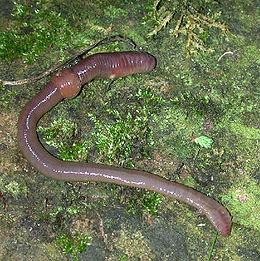Earthworm (Lumbricus polyphemus)
The Earthworm" redirects here. For other uses, see Earthworm (disambiguation).
Lumbricus terrestris, the Common Earthworm
Scientific classification:
Kingdom: Animalia
Phylum: Annelida
Class: Clitellata
Order: Haplotaxida
Suborder: Lumbricina (Burmeister, 1837)
Earthworm is the common name for the largest members of Oligochaeta (which is either a class or subclass depending on the author) in the phylum Annelida. In classical systems they were placed in the order Opisthopora, on the basis of the male pores opening posterior to the female pores, even though the internal male segments are anterior to the female. Theoretical cladistic studies have placed them instead in the suborder Lumbricina of the order Haplotaxida, but this may again soon change. Folk names for the earthworm include "dew-worm", "Rainworm", "night crawler" and "angleworm" (due to its use as fishing bait).
Earthworms are also called megadriles (or big worms), as opposed to the microdriles (or small worms) in the families Tubificidae, Lumbriculidae, and Enchytraeidae, among others. The megadriles are characterized by having a distinct clitellum (which is much more obvious than the single-layered one of the microdriles) and a vascular system with true capillaries.
Anatomy:
The basic body plan of an earthworm is a tube, the digestive system, within a tube, the muscular slimy, moist outer body. The body is annular, formed of segments that are most specialized in the anterior. Earthworms have a simple closed circulatory system. They have two main blood vessels that extend through the length of their body: a ventral blood vessel which leads the blood to the posterior end, and a dorsal blood vessel which leads to the anterior end. The dorsal vessel is contractile and pumps blood forward, where it is pumped into the ventral vessel by a series of "hearts" (aortic arches) which vary in number in the different taxa. The blood is distributed from the ventral vessel into capillaries on the body wall and other organs and into a vascular sinus in the gut wall, where gases and nutrients are exchanged. This arrangement may be complicated in the various groups by suboesophageal, supraoesophageal, parietal and neural vessels, but the basic arrangement holds in all earthworms. Most earthworms are decomposers feeding on undecayed leaf and other plant matter, others are more geophagous.
Digestion:
There is a digestion system in an earthworm. The process of nutrition begins in the mouth, where food is sucked in by a muscular pharynx. From there, food goes down the esophagus through peristalsis (visceral muscle contractions.) After this, the food is stored in the crop, which retains food and has the ability to expand. From there, food goes into the gizzard where sand and muscular contractions churn the food and increase the surface area. From there, food enters the intestine which has the ability to absorb food, then food exits through the anus. A rectum is unnecessary because an earthworm is in a moist environment and thus does not require water reclamation.
Behavior:
Earthworms can sometimes be found on the surface of the ground following heavy rain storms, as a storm may flood the soil with excessive water. However, if the surface where they find themselves is unexpectedly paved, rocky, or compacted (hardened), they may become stranded, potentially suffering injury or death from causes such as heat, exposure, dehydration, or predation. Note, there are some earthworm species that can survive for several days in water if it is sufficiently oxygenated.
Earthworms may also come to the surface during rain in order to mate, and therefore, an alternative hypothesis concerning "stranding" behavior is that as some species (notably Lumbricus terrestris) come to the surface to mate they may become stranded. However, this behavior is limited to only a few species and L. terrestris is rarely, if ever, one of those found stranded on impermeable surfaces, this hypothesis does not seem likely to be true.
Another hypothesis is that the worms may be using the moist conditions on the surface to travel more quickly than they can underground, thus moving to and colonizing new areas more quickly. Since the relative humidity of the surface and air is higher during and after rain, they do not become dehydrated quite as rapidly. However, if true, this is a very risky behavior near dawn, in high summer, or in the daytime, since earthworms die quickly when exposed to direct sunlight with its high heat, light and strong UV content, and are more vulnerable to predators such as birds.
wikipédia;
Csodálatos állatvilág gyűjtemény ;
www.agr.unideb.hu ;
Nagy Erika : Biológiából ötös
Hoczek László-Dr Folcz Tóbiás : Erdészeti állattan
